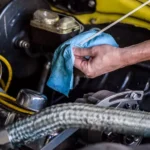Car exhaust systems are crucial for directing harmful gases away from the vehicle’s occupants and the environment. Maintaining their integrity is paramount for both safety and vehicle performance. This article focuses on welding Car Exhaust Pipe Tips, providing valuable insights for novice welders who want to tackle this task.
Understanding Car Exhaust Pipe Tips
Car exhaust pipe tips are more than just aesthetic enhancements. They protect the exhaust pipe’s end from corrosion and damage. Welding these tips requires specific techniques due to the thin metal involved.
Challenges of Welding Exhaust Pipes
Exhaust pipes are typically made from thin-gauge steel, which can be prone to burning through if not handled carefully. Additionally, the presence of rust and contaminants can further complicate the welding process.
Essential Equipment for Welding Car Exhaust Pipe Tips
While gas metal arc welding (MIG) with shielding gas is the preferred method for welding exhaust pipes, some hobbyists use flux-core welders. Here’s a breakdown of equipment needs:
- Welder: A MIG welder with gas capabilities is ideal for thin metal. If using a flux-core welder, ensure it has adjustable settings for wire speed and voltage.
- Wire: Use a wire diameter appropriate for the exhaust pipe’s thickness. 0.8mm wire is a common choice. For flux-core welding, use E71-TGS flux-core wire.
- Safety Gear: Welding requires proper safety precautions. This includes a welding helmet, gloves, and protective clothing.
- Cleaning Tools: Wire brush, grinder, and sandpaper are necessary for preparing the welding surface.
Preparing the Exhaust Pipe for Welding
Proper preparation is essential for a successful weld.
Cleaning the Metal
Thoroughly clean the exhaust pipe and tip using a wire brush, grinder, or sandpaper to remove rust, paint, and other contaminants. A clean surface allows for better penetration and a stronger weld.
Fitting the Tip
Ensure a tight fit between the exhaust pipe and the tip. A gap can lead to weak welds and leaks. Consider using a metal strip to reinforce the joint if necessary.
Welding Techniques for Car Exhaust Pipe Tips
Several techniques can be employed when welding car exhaust pipe tips:
Tack Welding
Start by tack welding the tip in place at several points around the circumference. This secures the tip and prevents movement during the final welding process.
Continuous Welding
Once tacked, use a continuous welding bead to join the tip to the pipe. Maintain a steady hand and consistent speed to avoid burning through the metal. If using a flux-core welder, short, successive tack welds can create a continuous joint.
Filling Gaps
If gaps exist, use a weaving technique to fill them with weld material. This ensures a strong and leak-free connection.
Common Mistakes and How to Avoid Them
- Burning Through: Reduce the heat input by lowering the amperage or using shorter welding bursts.
- Poor Penetration: Ensure proper cleaning and a tight fit between the pipe and tip.
- Spatter: Adjust the wire speed and voltage settings on your welder to minimize spatter. Using quality wire can also help.
- Weak Welds: Ensure proper penetration and use multiple passes if necessary. Consider reinforcing the joint with a metal strip.
Post-Welding Cleanup
After welding, remove any slag or spatter using a chipping hammer or wire brush. Painting the welded area can help prevent future rust and corrosion.
Seeking Professional Help
While welding car exhaust pipe tips can be a DIY project, consult a professional welder if you lack experience or the necessary equipment. A professional can ensure a safe and durable repair. Incorrectly welded exhausts can lead to dangerous leaks.
Conclusion
Welding car exhaust pipe tips requires practice and patience. Following these tips and taking necessary precautions will improve your chances of success. Remember to prioritize safety and seek professional help if needed. A properly welded exhaust system is vital for your vehicle’s performance and longevity.
